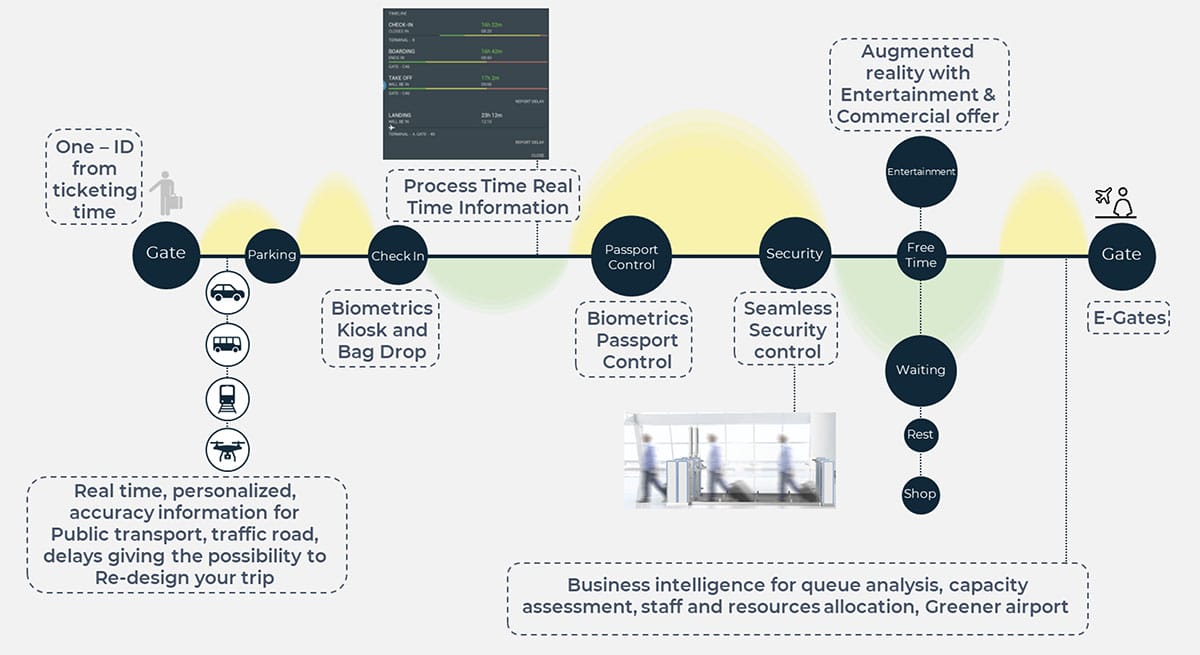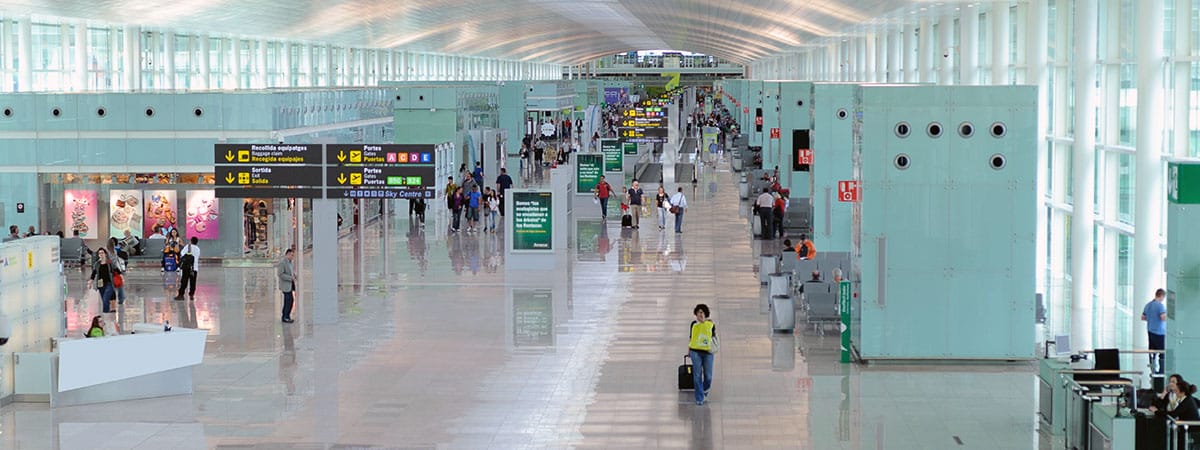When we design new airports or expand existing ones, proper needs planning is crucial in order for them to function properly. However, this sort of planning is currently falling short, because, in addition to considering capacity, we need to prioritize enhancing passenger experience.
In fact, this is a highly complex and difficult aspect, because passengers are becoming increasingly more demanding.
The main objective we should all be aiming for is turning airports from places you have to be into places you want to be.
Passenger experience has evolved so much that in order to attract them to our airports we cannot rest on our laurels with a good offering of destinations and connections, we have to consider and analyse what happens from the time the passenger leaves their home up until the time they come back.
This means the airports of the future must be seamless, smarter, friendlier, greener and safer. All of these design concepts are related and should be applied with a deep understanding of what passengers do at airports and how their behaviour has been evolving.

Seamless airports must include proactive services with fluid interactions between processes, given that they allow solutions anticipating passengers’ needs and preferences to be added in real time.
We need to facilitate the entire travel process for passengers, from the very beginning, before they arrive at the airport, until the end, when they land at the airport and are looking to get home or to their hotel as quickly as possible. To do that we need to incorporate a mobility strategy into airport processes.
Designing an adequate wayfinding system for passengers is also key, understanding that airports have complex designs that are dynamic, multilingual environments with a diverse pool of passengers.
New trends include digital signage with real-time information including: distance and time to the gate based on existing demand and baggage information and status at baggage claim (baggage being offloaded, baggage offloaded, baggage at security checkpoint, baggage on claim carrousel, etc.), which reduces passenger anxieties and consequently improves the perceived quality of the airport.
To create a smarter airport, all airport processes must be carried out very efficiently to improve passenger experience. This requires developing an IT Master Plan including the technological systems offering operational improvements for all stakeholders.
The solutions available that adapt to each airport must be explored, considering the increasingly significant role IoT (internet of things), AI (artificial intelligence), and emerging technologies play in reducing process times. Once this goal has been achieved, passengers can decide what they want to do with their time at the airport, allowing them to spend it in shopping, food and beverage, and entertainment areas instead of queuing.
We need to understand passenger behaviour and the level of stress they feel during their time in the terminal building as part of their trip in order to give passengers more control over their trip and a more fluid and efficient experience.
Passengers can go from green, no stress (mainly in the shopping and F&B areas), to yellow, in which passengers usually begin thinking about their trip in advance: What time or how far in advance should I arrive at the airport? Where can I park my car near the terminal building? The stress level increases before they check their luggage as they ask themselves: Where can I check my luggage? How long will it take?
The most stressful process is security, which lowers passenger experience, followed by passport control.

In practice, we can reduce passenger stress levels and therefore improve their time at the airport by incorporating systems and processes that make the airport smarter.
To make friendlier airports we need to personalise the experiences they offer, giving passengers a pleasant, memorable, inclusive experience.
Some details that will help make an airport friendlier are:
- Giving a positive feeling about the place where the airport is located including architectural components influenced by the local culture, art, and regional customs.
- Similarly, culinary options at the airport should provide a variety of choices for all passenger tastes. Airport restoration can help build passenger memories, rounding out their travel experience.
- To reduce stress, green areas must be included: large open spaces for concerts and exhibits, play areas for kids, exercise areas, as well as audiovisual entertainment.
- Wellness and de-stressing areas as well as work areas should be included to cover passenger needs. For this, both the design of the areas as well as the furniture selection should be carefully analysed.
- Another relevant objective is finding a wide open space at the airport that is calm and gives off a happy feeling for all passengers before boarding the plane.
- Including exclusive lounges is another key point when prime and business passengers choose airports, even more so for connecting passengers.
As far as shopping areas are concerned, it is important to find the best location for restaurant and retail areas as well as defining the size and type of establishment so as to have an adequate commercial offering at each step of the process, from check-in to the gate, making the most of passengers’ opportunities to spend in waiting areas close to the gate, such as in the pier design. Several points need to be considered to do this:
- Provide adequate commercial offerings at all steps of the passenger process “from check-in to the gate”.
- Guarantee that commercial offerings are located within and throughout the passenger flow toward gates.
- Food and beverage businesses should be mixed with retail businesses, not separated into exclusively designated shopping areas, so as to increase passenger exposure to these businesses.
- Shopping areas at top-tier airports are open spaces. They do not overuse physical separators and employ an open plan, using interior architectural tools (lighting, flooring, etc.). Thus, shopping areas are integrated into the flow of passengers without hindering or reducing their comfort.
- In the case of arrivals, there is usually a duty free shop and there should be a food and beverage and retail area for companions/visitors.
In addition to these criteria, it is helpful to identify tools that provide passengers with the information on retail, food and beverage, and leisure/entertainment areas before they arrive at the airport. This information should be personalized based on criteria like the amount of time they will be at the airport, their origin and destination, whether they will be connecting, and the purpose of their trip (business/holiday).
Personalising this information is quite challenging. It requires obtaining real data about passengers without violating data protection policies.
Nonetheless, there are alternative ways around this. One of them is to involve the airlines that usually fly to our airports, asking them to provide that information on their flights. Passengers spend hours on the plane and can make the most of the flight to plan their time at the airport. They can make a reservation at a restaurant, book a massage or salon appointment, plan to spend time at the gym, or purchase an item from an airport shop and choose to pick it up when they arrive.
Another airport improvement criterion is sustainability.
We need to utilise environmentally friendly solutions to make air transport and all of our airports increasingly sustainable. To do that, we need to start by complying with Sustainability Action Plan programmes and initiatives, working from a circular economy perspective starting in the design phase. To be considered:
- The technology is mature enough to improve energy efficiency and create renewable energy solutions.
- The use of local resources to reduce emissions in the transport of food and other goods, as well as actions to reduce the use of plastics.
- Airports are ecosystems through which large amounts of people travel, so driving CSR initiatives at the airport will have a positive impact for passengers and the entire airport environment.
- Many solutions can be applied to take on biodiversity impacts, such as green canopies and creating fields for a variety of purposes within airport facilities.
Including embedded technology designed to ensure the airport is safer from initial detection to final response.
Having efficient and effective operations without losing sight of passenger experience depends largely on the technological systems supporting airport operations. That is why new technological solutions should be considered from the very beginning of the design phase, both on new terminals and on expansions and remodels.
To achieve airport digital transformation, we need a variety of technological tools supporting an enhanced, predictable experience for passengers, personnel, airlines, and all other stakeholders.
The cost of implementing these technological solutions at airports should be analysed in detail. Nonetheless, just as flying 40 years ago was a privilege of the few because of its cost, this technology is increasingly inexpensive. The use of new technologies, their flexibility and scalability, and the positive impacts that implementing them will have on capacity and service will reduce operating costs.
There is no such thing as a perfect terminal model, airports need to adapt to our passengers and attempt to create a design that covers the demands and meets the expectations of the largest number of passengers. This is certainly a challenging exercise and an inspiring challenge for the people who design airports.
The goal is to turn airports from places you have to be into places you want to be. When we achieve this goal, the benefits are two-fold: on the one hand, we improve passenger experience, and, on the other, there is an increase in business earnings resulting, therefore, in benefits for passengers and airport operators.



